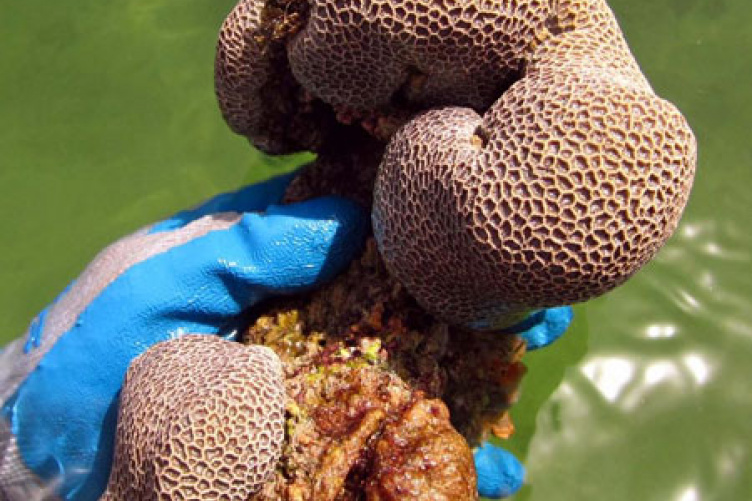Left - Juvenile pearl oysters attached to seagrass and rock, covering the bottom of some areas.
Right - Sample of coral taken from a shallow lagoon reef in Umm Al Quwain
UNH Scientists Lead International Effort to Aid Emirates
Many people traveling on business settle down to watch TV in their hotel rooms after a hard day’s work. Not marine biologist Krystin Ward ’06. She settles down to pour through research findings collected during the day from the coastal zone of the United Arab Emirates (UAE) to help keep people safe from red tide.
|
|
In addition, she tweets up-to-the-minute news and photographs about the team’s varied research endeavors from @ChoiceOysters.
A research technician in the College of Life Sciences and Agriculture, Ward works with mollusk expert and professor of biological sciences, Ray Grizzle. Stationed in the UAE for ten days at a time, Grizzle and Ward work closely with an international group of marine biologists to better understand the effects of red tide – poisonous toxins that can be transmitted through consumption of shellfish affected by red tide blooms – that have recently plagued the region.
“A major focus of the our work has been to provide the UAE’s Ministry of Environment and Water with information on the mollusk species most likely to be eaten by people,” says Grizzle. The mollusk study has also led to additional research by Grizzle and Ward on coral reefs and mangroves in the Arabian Gulf and the Sea of Oman. For this work, they are teaming with professor of biological sciences Gregg Moore – as well as marine biologist John Burt of NYU Abu Dhabi – to provide the Ministry of Environment and Water with maps of coral reefs and mangrove habitat throughout the UAE coastal zone.
Ward wields much of the high-tech equipment, including an underwater video camera and GPS system that will enable the scientists to create detailed maps of the coral and mangroves. “Abu Dhabi and Dubai have environmental surveys; now the Ministry of Environment and Water needs to expand into the other five emirates,” says Grizzle, who compares the UAE’s agency to the United States’ Environmental Protection Agency (EPA) after the Clean Water Act was passed. “It’s a mutually beneficial situation,” says Grizzle. “We get to work in an area that we’ve not been in before, and help a young country develop an administrative and regulatory framework for environmental management.”
A Record of Natural History
In addition to lending their expertise to the Ministry of Environment and Water, Grizzle and Ward have been amassing shells for a reference collection held at UNH’s Jackson Estuarine Lab on Little Bay in Durham, N.H. Grizzle says the reference collection serves two purposes: “If the identity of a shell needs to be verified or if there are questions about the mollusks we used . . . here they are. Also, people want to have archived shells in case there is a name change in the future.” Grizzle and Ward have collected, cleaned, and dried hundreds of specimens since they began this work in 2010. Currently, Grizzle is working on a manuscript about the survey of mollusks in the UAE that will be published in the Journal of Shellfish Research upon its completion.
With a focus on conservation, Grizzle and Ward’s research spans a world of environmental resources and constructs a record of natural history through collaboration.



















































